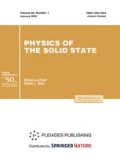Abstract
The paper presents a numerical study, within a nonlinear generalization of the classical Ericksen–Leslie theory, of a new nonlinear mechanism for the formation of the regime of shock pressure on the boun-ding walls of a microsized twisted nematic cell (TNC), realized in the form of the kinklike traveling wave \(\mathcal{P}\)(z – \({v}t\)) under the effect of the externally applied electric field and induced by a strong local distribance of the director field in the form of a Gaussian (normal) distribution. The mechanisms responsible for the formation of the traveling wave of shock pressure propagating in the TNC from one of its boundaries to another are studied, and it is shown how the magnitude of the electric field and the shape of the localized initial perturbation of the director field affect the similarity of the traveling wave to the kinklike wave. Studies of the dynamic relaxation of the director field in TNCs also showed that, at temperatures exceeding the temperature for the nematic–smectic A (NA) TNA phase transition by several dozen mK, fluctuations in the order parameter of the emerging smectic phase suppress the effect of the electric field and favor the singular behavior of the azimuthal anchoring energy density as T → TNA.








Similar content being viewed by others

REFERENCES
D. K. Yang and S. T. Wu, Fundamentals of Liquid Crystal Devices (Wiley, New York, 2006).
A. V. Dubtsov, S. V. Pasechnik, D. V. Shmeliova, V. A. Tsvetkov, and V. G. Chigrinov, Appl. Phys. Lett. 94, 181910 (2009).
I. C. Khoo, Liquid Crystals: Physical Properties and Nonlinear Optical Phenomena (Wiley, New York, 1995).
A. P. H. J. Schenning, G. P. Crawford, and D. J. Broer, Liquid Crystal Sensors (CRC, Taylor and Francis Group, Boca Raton, 2018).
P. G. de Gennes and J. Prost, The Physics of Liquid Crystals, 2nd ed. (Oxford Univ. Press, Oxford, 1995).
A. V. Zakharov and A. A. Vakulenko, Phys. Rev. E 72, 021712 (2005).
I. W. Stewart, The Static and Dynamic Continuum Theory of Liquid Crystals (Taylor and Francis, London, 2004).
J. L. Ericksen, Arch. Ration. Mech. Anal. 4, 231 (1960).
F. M. Leslie, Arch. Ration. Mech. Anal. 28, 265 (1968).
W. van Saarloos, Phys. Rev. A 37, 211 (1988).
A. N. Kolmogorov, I. G. Petrovskii, and N. S. Piskunov, Byull. Mosk. Univ., Ser. A: Mat. Mekh. 1, 1 (1937).
A. Rapini and M. Papoular, J. Phys. Colloq. (France) 30, C4-541 (1969).
I. S. Berezin and N. R. Zhidkov, Methods of Calculations (Fizmatgiz, Moscow, 1964).
M. Vilfan and M. Copic, Phys. Rev. E 68, 031704 (2003).
A. Sugimura, K. Matsumoto, O. Y. Zhong-Can, and M. Iwamoto, Phys. Rev. E 54, 5217 (1996).
J. Thoen, H. Marynissen, and W. van Dael, Phys. Rev. Lett. 57, 94 (1984).
D. Davidov, C. R. Safynia, M. Kaplan, S. S. Dana, R. Schaetzing, R. J. Birgeneau, and J. D. Lister, Phys. Rev. B 19, 1657 (1979).
D. Kamada, K. Okimoto, A. Sugimura, G. R. Luckhurst, B. A. Timimi, and H. Zimmermann, Mol. Cryst. Liq. Cryst. 441, 129 (2005).
J. G. Fonseca and Y. Galerne, Phys. Rev. E 61, 1550 (2000).
Funding
This work was supported by the Ministry of Education and Science of the Russian Federation (grants nos. 3.11888.2018/11.12 and 3.9585.2017/8.9).
Author information
Authors and Affiliations
Corresponding author
Ethics declarations
The authors declare that they have no conflicts of interest.
Additional information
Translated by E. Chernokozhin
Rights and permissions
About this article
Cite this article
Zakharov, A.V., Pasechnik, S.V. Formation of the Shock Pressure Regime in the Form of a Traveling Wave in Nematic Twisted Cells. Phys. Solid State 62, 359–367 (2020). https://doi.org/10.1134/S1063783420020213
Received:
Revised:
Accepted:
Published:
Issue Date:
DOI: https://doi.org/10.1134/S1063783420020213



